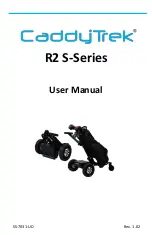
Read the following warnings before operating vehicle:
To prevent personal injury or death, observe
the following:
When vehicle is to be left unattended,
engage park brake, move direction
selector to neutral, turn key to OFF
position and remove from key switch.
Drive vehicle only as fast as terrain
and safety considerations allow. Con-
sider environmental factors which
effect the terrain and the ability to
control the vehicle.
Avoid driving fast down hill. Sudden
stops or change of direction may
result in loss of control. Use service
brake to control speed when traveling
down an incline.
Use extra care and reduced speed
when driving on poor surfaces, such
as loose dirt, wet grass, gravel, etc.
All travel should be directly up or
down hills; use extra care if ever
forced to drive across an incline.
Stay in designated areas and avoid
steep slopes. Activate the park brake
when the vehicle is parked.
Keep feet, legs, hands and arms
inside vehicle at all times.
Avoid extremely rough terrain.
Check area behind the vehicle before
operating in reverse.
Make sure direction selector is in
desired position before starting the
vehicle.
Slow down before and during turns.
All turns should be executed at
reduced speed.
Always bring vehicle to a complete
stop before shifting direction selector.
See GENERAL SPECIFICATIONS
for vehicle load and seating capacity.
Read the following information and warnings before
operating vehicle:
In any product, components will eventually fail to perform prop-
erly as the result of normal use, age, wear or abuse.
It is virtually impossible to anticipate all possible component
failures or the manner in which they may fail.
A vehicle requiring repair indicates that it is no longer function-
ing as designed and therefore should be considered poten-
tially hazardous.
Use extreme care when working on vehicle. When diagnosing,
removing or replacing any components that are not operating
properly, take time to consider the safety of yourself and others
around you should the component move unexpectedly.
Some components are heavy, spring loaded, highly corrosive,
explosive, may produce high amperage or reach high temper-
atures. Battery acid and hydrogen gas could result in serious
bodily injury to the technician/mechanic and bystanders if not
treated with utmost caution. Be careful not to place hands,
face, feet or body in a location that could expose them to injury
should an unexpected situation occur.
Always use the appropriate tools listed in the tool list and wear
approved safety equipment.
Before working on vehicle, remove all jew-
elry (rings, watches, necklaces, etc.).
Be sure no loose clothing or hair can contact
moving parts.
Use care not to touch hot objects.
Raise rear of vehicle and support on jack
stands before running or adjusting power-
train.
Wear eye protection when working on or
around the vehicle. In particular, use care
when working around batteries, using sol-
vents, or compressed air.
Hydrogen gas forms when charging batteries.
Do not charge batteries without adequate
ventilation.
Do no permit open flame or smokers in an
area being used for charging batteries. A
concentration of 4% hydrogen gas or more is
explosive.


















